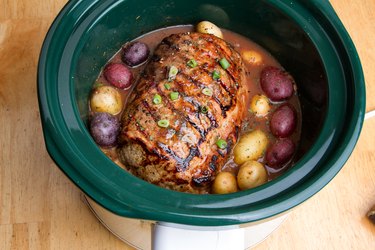
Cooking an arm roast in the oven can save you time, which is great news when you're trying to put dinner on the table after a long day at work. Plus, it's versatile and flavorful. So, it's an excellent choice for pot roast, or you can cut it up and add it to your favorite beef stew recipe.
Bake an Arm Roast in the Oven
Video of the Day
If you're not familiar with the term "arm roast," it might be because it's also known by several other names. According to the Cattlemen's Beef Board and National Cattlemen's Beef Association, this cut of meat may be labeled chuck arm roast, chuck arm pot roast, shoulder pot roast, among others.
Video of the Day
One of the best features of an arm roast is the flexibility it provides when it comes to cooking. In addition to baking an arm roast in the oven, the University of Nebraska-Lincoln says you can braise, grill, pan-broil, pan-fry, or broil a chuck arm roast, although braising seems to be the top pick, especially if you want tender arm roast.
If you're baking a beef roast in the oven, it's best to use the roasting method. That said, the amount of time it takes to reach a safe internal temperature of 145 degrees Fahrenheit will vary depending on the thickness of the meat.
That's why it's best to consult the oven roasting basics guidelines from the Cattlemen's Beef Board and National Cattlemen's Beef Association. In general, you can expect this cut of meat to take quite a bit longer than other meats, with some taking one to three hours.
Read more: How to Cook a Chuck Roast Perfectly
Chuck Roast Ideas
Searching for the perfect cut of meat is only half the battle. You also need to know what to do with it when you get home. The good news? There are a ton of chuck roast ideas that will satisfy your meat craving.
Since arm roast or chuck roast is a great cut for pot roast and stew, it makes the perfect addition to a winter-time comfort meal plan. All you need to do is combine the beef with the stock of your choice (chicken, beef or vegetable), carrots, onions, potatoes and seasonings, and you have the perfect meal solution. Serve it with whole-grain bread and our Autumn Spinach Salad, Steamed Broccoli Florets or Chopped Almond String Beans for a nutritious, satisfying meal.
Plus, this type of feast is great for leftovers for the rest of the week. And in case you need some inspiration, check out our recipes for Slow Cooker Beef Stew, Mississippi Roast and Japanese Beef Curry.
Safety and Purchasing Tips
When purchasing arm roast, look for a packaging label that also contains nutritional information. According to the Academy of Nutrition and Dietetics, major cuts of single-ingredient, raw meat must have a product label that contains nutrition information, such as total calories, calories from fat, total fat, saturated fat, cholesterol and total carbohydrates.
Prepping and cooking beef at home requires knowledge of food safety. In order to kill the harmful bacteria in raw meat and reduce the risk of foodborne illnesses, the Centers for Disease Control and Prevention says you need to wash surfaces before, during and after preparing food; separate raw meat from other ready-to-eat foods; cook food to the right internal temperature; and store leftovers in the refrigerator within two hours of cooking.
The right internal food temperature for beef, according to the USDA Food Safety and Inspection Service is 145 F, as measured by a food thermometer. Make sure to let the meat sit for three minutes before checking the temperature.
- Cattlemen's Beef Board and National Cattlemen's Beef Association: "Arm Chuck Roast"
- University of Nebraska-Lincoln, Institute of Agriculture and Natural Resources: "Meat Cuts ID & Cooking Recommendations"
- Academy of Nutrition and Dietetics: "What Meat Nutrition Labels Mean"
- USDA Food Safety and Inspection Service: "Safe Minimum Internal Temperature Chart"
- Centers for Disease Control and Prevention: "Key Facts About Food Poisoning"
- Cattlemen's Beef Board and National Cattlemen's Beef Association: "Oven Roasting Basics"